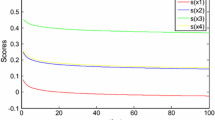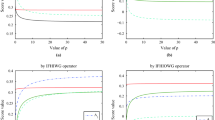Abstract
With respect to multiple attribute decision-making problems with interval-valued intuitionistic fuzzy information, some operational laws of interval-valued intuitionistic fuzzy numbers, correlation and correlation coefficient of interval-valued intuitionistic fuzzy sets are introduced. An optimization model based on the negative ideal solution and max-min operator, by which the attribute weights can be determined, is established. We utilize the interval-valued intuitionistic fuzzy weighted averaging operator proposed by Xu (Control Decis 22(2):215–219, 2007) to aggregate the interval-valued intuitionistic fuzzy information corresponding to each alternative, and then rank the alternatives and select the most desirable one(s) according to the correlation coefficient. Finally, an illustrative example is given to verify the developed approach and to demonstrate its practicality and effectiveness.
Similar content being viewed by others
References
Atanassov K (1986) Intuitionistic fuzzy sets. Fuzzy Sets Syst 20: 87–96
Atanassov K (1989) More on intuitionistic fuzzy sets. Fuzzy Sets Syst 33: 37–46
Zadeh LA (1965) Fuzzy sets. Inf Control 8: 338–356
Gau WL, Buehrer DJ (1993) Vague sets. IEEE Trans Syst Man Cybern 23(2): 610–614
Bustince H, Burillo P (1996) Vague sets are intuitionistic fuzzy sets. Fuzzy Sets Syst 79: 403–405
Chen SM, Tan JM (1994) Handling multicriteria fuzzy decision-making problems based on vague set theory. Fuzzy Sets Systems 67: 163–172
Hong DH, Choi CH (2000) Multicriteria fuzzy decision-making problems based on vague set theory. Fuzzy Sets Systems 114: 103–113
Li DF (2005) Multiattribute decision making models and methods using intuitionistic fuzzy sets. J Comp Syst Sci 70: 73–85
Lin L, Yuan XH, Xia ZQ (2007) Multicriteria fuzzy decision-making methods based on intuitionistic fuzzy sets. J Comp Syst Sci 73: 84–88
Li DF (2008) Extension of the LINMAP for multiattribute decision making under Atanassov’s intuitionistic fuzzy environment. Fuzzy Optim Decis Mak 7(1): 17–34
Liu HW, Wang GJ (2007) Multi-criteria decision-making methods based on intuitionistic fuzzy sets. Eur J Oper Res 179(1): 220–233
Li DF (2004) Some measures of dissimilarity in intuitionistic fuzzy structures. J Comp Syst Sci 68(1): 115–122
Li DF, Wang YC, Liu S, Shan F (2009) Fractional programming methodology for multi-attribute group decision making using IFS. Appl Soft Comput J 9(1): 219–225
Ye J (2007) Improved method of multicriteria fuzzy decision-making based on vague sets. Comput Aided Design 39: 164–169
Wei GW (2008) Maximizing deviation method for multiple attribute decision making in intuitionistic fuzzy setting. Knowl Based Syst 21(8): 833–836
Atanassov K, Pasi G, Yager RR (2005) Intuitionistic fuzzy interpretations of multi-criteria multiperson and multi-measurement tool decision making. Int J Syst Sci 36: 859–868
Szmidt E, Kacprzyk J (1996) Intuitionistic fuzzy sets in group decision making. NIFS 2(1): 15–32
Szmidt E, Kacprzyk J (1996) Remarks on some applications of intuitionistic fuzzy sets in decision making. NIFS 2(3): 22–31
Szmidt E, Kacprzyk J (1996) Group decision making via intuitionistic fuzzy sets, FUBEST’96, Sofia, Bulgaria, October 9–11, pp 107–112
Szmidt E, Kacprzyk J (1997) Intuitionistic fuzzy sets for more realistic group decision making. In: International Conference transition to advanced market institutions and economies, Warsaw, June 18–21, pp 430–433
Szmidt E, Kacprzyk J (2001) Entropy for intuitionistic fuzzy sets. Fuzzy Sets Syst 118: 467–477
Szmidt E, Kacprzyk J (2001) Distances between intuitionistic fuzzy sets. Fuzzy Sets Syst 114: 505–518
Bustince H (2000) Construction of intuitionistic fuzzy relations with predetermined properties. Fuzzy Sets Syst 109: 379–403
Li DF, Cheng CT (2002) New similarity measures of intuitionistic fuzzy sets and application to pattern recognitions. Pattern Recognit Lett 23(1–3): 221–225
Szmidt E, Kacprzyk J (2002) Using intuitionistic fuzzy sets in group decision making. Control Cybern 31: 1037–1053
Szmidt E, Kacprzyk J (2003) A consensus-reaching process under intuitionistic fuzzy preference relations. Int J Intell Syst 18: 837–852
Atanassov K, Gargov G (1989) Interval-valued intuitionistic fuzzy sets. Fuzzy Sets Syst 31: 343–349
Atanassov K (1994) Operators over interval-valued intuitionistic fuzzy sets. Fuzzy Sets Syst 64(2): 159–174
Bustince H, Burillo P (1995) Correlation of interval-valued intuitionistic fuzzy sets. Fuzzy Sets Syst 74: 237–244
Hong DH (1998) A note on correlation of interval-valued intuitionistic fuzzy sets. Fuzzy Sets Syst 95: 113–117
Mondal TK, Samanta SK (2001) Topology of interval-valued intuitionistic fuzzy sets. Fuzzy Sets Syst 119: 483–494
Grzegorzewski P (2004) Distances between intuitionistic fuzzy sets and/or interval-valued fuzzy sets based on the Hausdorf metric. Fuzzy Sets Syst 148: 319–328
Wei GW (2009) Some geometric aggregation functions and their application to dynamic multiple attribute decision making in intuitionistic fuzzy setting. Int J Uncertain Fuzziness Knowl Syst 17(2): 179–196
Park KS, Kim SH (1997) Tools for interactive multi-attribute decision making with incompletely identified information. Eur J Oper Res 98: 111–123
Kim SH, Choi SH, Kim JK (1999) An interactive procedure for multiple attribute group decision making with incomplete information: rangebased approach. Eur J Oper Res 118: 139–152
Kim SH, Ahn BS (1999) Interactive group decision making procedure under incomplete information. Eur J Oper Res 116: 498–507
Park KS (2004) Mathematical programming models for charactering dominance and potential optimality when multicriteria alternative values and weights are simultaneously incomplete. IEEE Trans Syst Man Cybern A Syst Humans 34: 601–614
Zimmermann HJ, Zysco P (1980) Latent connectives in human decision making. Fuzzy Sets Syst 4: 37–51
Herrera F, Herrera-Viedma E (2000) Linguistic decision analysis: steps for solving decision problems under linguistic information. Fuzzy Sets Syst 115: 67–82
Xu ZS (2007) Methods for aggregating interval-valued intuitionistic fuzzy information and their application to decision making. Control Decis 22(2): 215–219
Xu ZS, Chen J (2008) An overview of distance and similarity measures of intuitionistic fuzzy sets. Int J Uncertain Fuzziness knowl Syst 16(4): 529–555
Lai YJ, Liu TY, Hwang CL (1994) TOPSIS for MODM. Eur J Oper Res 76(3): 486–500
Teng ZX, Du WL (2009) A hybrid multi-group approach for privacy-preserving data mining. Knowl Inf Syst 19(2): 133–157
Zhang WG, Xiao WL (2009) On weighted lower and upper possibilistic means and variances of fuzzy numbers and its application in decision. Knowl Inf Syst 18(3): 311–330
Xia F, Zhang WSF, Li FX, Yang YW (2008) Ranking with decision tree. Knowl Inf Syst 17(3): 381–395
Alvarado M, Rodríguez-Toral MA, Rosas A, Ayala S (2007) Decision-making on pipe stress analysis enabled by knowledge-based systems. Knowl Inf Syst 12(2): 255–278
Wei GW (2009) Uncertain linguistic hybrid geometric mean operator and its Application to group decision making under uncertain linguistic environment. Int J Uncertain Fuzziness Knowl Syst 17(2): 251–267
Wei GW (2008) Induced intuitionistic fuzzy ordered weighted averaging operator and its application to multiple attribute group decision making. In: Lecture Notes in Artificial Intelligence 5009, pp 124–131
Wei GW (2009) Some induced geometric aggregation operators with intuitionistic fuzzy information and their application to group decision making. Appl Soft Comput (in press)
Wei GW (2009) Extension of TOPSIS method for 2-tuple linguistic multiple attribute group decision making with incomplete weight information. Knowl Inf Syst (in press)
Author information
Authors and Affiliations
Corresponding author
Rights and permissions
About this article
Cite this article
Wei, Gw., Wang, HJ. & Lin, R. Application of correlation coefficient to interval-valued intuitionistic fuzzy multiple attribute decision-making with incomplete weight information. Knowl Inf Syst 26, 337–349 (2011). https://doi.org/10.1007/s10115-009-0276-1
Received:
Revised:
Accepted:
Published:
Issue Date:
DOI: https://doi.org/10.1007/s10115-009-0276-1




